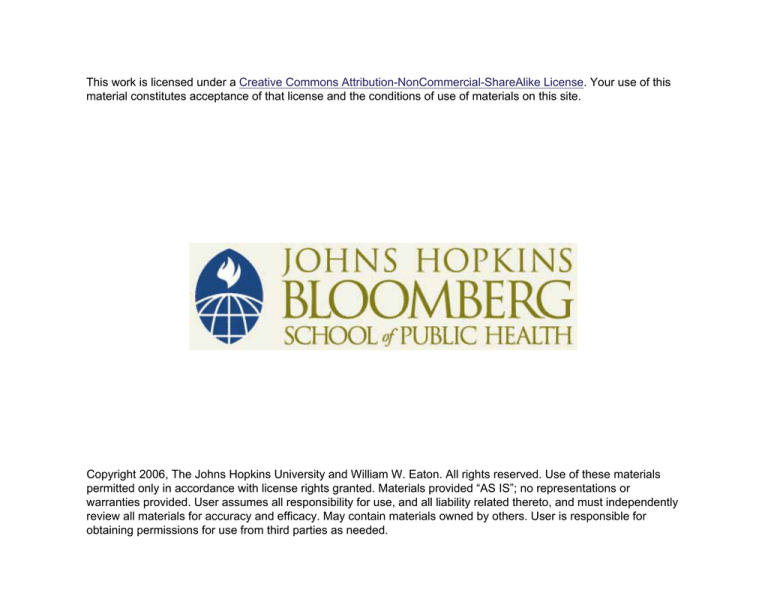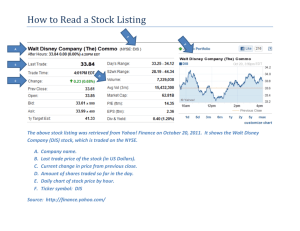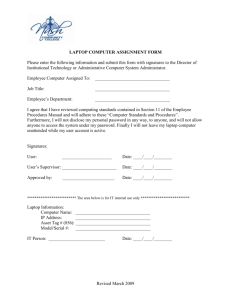
This work is licensed under a Creative Commons Attribution-NonCommercial-ShareAlike License. Your use of this
material constitutes acceptance of that license and the conditions of use of materials on this site.
Copyright 2006, The Johns Hopkins University and William W. Eaton. All rights reserved. Use of these materials
permitted only in accordance with license rights granted. Materials provided “AS IS”; no representations or
warranties provided. User assumes all responsibility for use, and all liability related thereto, and must independently
review all materials for accuracy and efficacy. May contain materials owned by others. User is responsible for
obtaining permissions for use from third parties as needed.
Measurement of Psychopathology in
Populations
William W. Eaton, PhD
Johns Hopkins University
Section A
Introduction
Definitions
Sign and symptom
Behavior and complaint
Syndrome
Ë Co-occurrence of signs and symptoms
Continued
4
Definitions
Reliability
Ë Consistency of measurement
Validity
Ë Measuring what is supposed to be measured
Construct validity
Ë Agreement with theoretical predictions across a range
of theories and across a range of modalities of
measurement
5
Measurement Issues for Twelve Psychiatric Disorders
Diagnosis
Autism
Attention Deficit
Conduct Disorder
Eating Disorders
Agoraphobic
Disorder
Panic Disorder
Social Phobic
Disorder
Alcohol Disorder
Major Depression
Schizophrenia
Bipolar Disorder
Dementia
Lifetime
prevalence
percent
0.05
6.2
5.4
1.2
5.3
Problem
with
Insight
√√√
√
√
√
1.6
1.7
13.0
9.0
0.3
0.6
4.9
Complexity
of DSM
Criteria
++
++
++
+
+
+
+
√
√√
√√
√√√
Data from Reviews in Eaton, The Sociology of Mental Disorders, 3rd. Ed. (2001)
+
++
++
++
+
6
Prevalence
Prevalence—proportion of the population with the disorder
Ë Lifetime—proportion who have, or have ever had, the
disorder
Ë Point—proportion who have the disorder now
Ë Period—proportion who have the disorder during a
stated period of time
7
Incidence
Incidence—rate at which new cases form
Ë Attack rate—rate at which cases form, during a stated
period of follow-up, from a population of individuals
who do not have the disorder at baseline
Ë First lifetime incidence—rate at which cases form,
during a stated period of follow-up, from a population
of individuals who have never had the disorder at
baseline
8
Rates and Proportions in Epidemiology Survey Method
Rate
Minimum
Design
Numerator
Denominator
Lifetime prevalence
Cross section
Ever ill
Alive at survey
Point prevalence
Cross section
Currently ill
Alive at survey
Period prevalence (1)
Cross section
ill during period
Alive at survey
Period prevalence (2)
Two waves
ill during period
Alive during period
First incidence
Two waves
Newly ill
Never been ill-baseline
Attack rate
Two waves
Newly ill
Not ill-baseline
PCA
Birth to present
Ever ill
Born
Lifetime risk
Birth to death
Ever ill
Born
Adapted from Eaton. 2001
9
Rates and Proportions in Epidemiology Register Method
Rate
Numerator
Denominator
Lifetime prevalence
Difficult
Census count
Point prevalence
Resident patients
Census count
Period prevalence (1)
Difficult
Census count
Period prevalence (2)
Resident patients plus
admissions
Census average
First incidence
Unduplicated first admissions
Census average
Attack rate
Admissions
Census average
PCA
Difficult
Vital statistics
Lifetime risk
Difficult
Vital statistics
10
Section B
Structured Diagnostic Interview
Example: DIS Panic Disorder
DSM-IV Criteria for Panic Attack
A fearful spell in which four or more symptoms developed
and peaked within ten minutes
Ë Palpitations, pounding heart
Ë Sweating
Ë Trembling or shaking
Ë Shortness of breath or smothering
Ë Feeling of choking
Ë Chest pain
Ë Nausea
Ë Feeling dizzy or faint
Ë De-realization or depersonalization
Ë Numbing or tingling sensation
Ë Chills or hot flashes
12
DSM-IV Criteria for Panic Disorder
Both (1) and (2)
(1) Recurrent unexpected panic attacks
(2) One month or more of the following:
(a) Concern about additional attacks
(b) Worry about consequences
(c) Change in behavior related to attacks
13
Structure of Diagnostic Interview
Continued
14
DIS Questionnaire Page on Panic Disorder
15
Laptop Version of DIS Panic
16
Laptop Version of DIS Panic
17
Laptop Version of DIS Panic
18
Laptop Version of DIS Panic
19
Laptop Version of DIS Panic
20
Laptop Version of DIS Panic
21
Laptop Version of DIS Panic
22
Laptop Version of DIS Panic
23
Laptop Version of DIS Panic
24
Laptop Version of DIS Panic
25
Laptop Version of DIS Panic
26
Laptop Version of DIS Panic
27
Laptop Version of DIS Panic
28
Laptop Version of DIS Panic
29
Laptop Version of DIS Panic
30
Laptop Version of DIS Panic
31
Laptop Version of DIS Panic
32
Laptop Version of DIS Panic
33
Laptop Version of DIS Panic
34
Laptop Version of DIS Panic
35
Laptop Version of DIS Panic
36
Laptop Version of DIS Panic
37
Laptop Version of DIS Panic
38
Laptop Version of DIS Panic
39
Laptop Version of DIS Panic
40
Laptop Version of DIS Panic
41
Laptop Version of DIS Panic
42
Laptop Version of DIS Panic
43
Laptop Version of DIS Panic
44
Laptop Version of DIS Panic
45
Laptop Version of DIS Panic
46
Laptop Version of DIS Panic
47
Laptop Version of DIS Panic
48
Laptop Version of DIS Panic
49
Laptop Version of DIS Panic
50
Laptop Version of DIS Panic
51
Laptop Version of DIS Panic
52
Laptop Version of DIS Panic
53
Laptop Version of DIS Panic
54
Laptop Version of DIS Panic
55
Laptop Version of DIS Panic
56
Laptop Version of DIS Panic
57
Laptop Version of DIS Panic
58
Interviewers
Professional interviewers are likely to be . . .
Ë Middle-aged
Ë Females
Ë Less than college educated
Ë Articulate
59
Field Work
Interviewer attrition during training > 50%
Pay by hour is preferable to by piece
> 10% validation
7–15 interviewers per interview supervisor
1–2 weeks training
60
Section C
Structured Survey versus Clinical Examination
Baltimore ECA Wave 1 and Follow-Up
Survey Interviews and Psychiatrist Examinations; 1981–1996
3481 Survey (DIS)
Interviews in 1981
(412)
1920 Survey (DIS)
Interviews in 1993–
1996
(73% of Survivors)
810 Psychiatrist Examinations
(SPE)
(111)
349 Psychiatrist Examinations
(SCAN)
62
Baltimore ECA Wave 1 Kappa
Estimated Kappa Based upon a Cross-Classification of
DIS/DSM-III One-Month Diagnoses and CR/DSM-III
One Month Diagnoses
DSM-III Category
Kappa
Alcohol-use disorder
0.35 (0.21, 0.49)
Major depressive episode
0.25 (0.19, 0.32)
Phobic disorder
0.24 (0.16, 0.31)
Schizophrenia
0.19 (-0.005, 0.29)
Manic episode
0.09 (-0.004, 0.22)
Drug-use disorders
0.08 (0.03, 0.20)
Obsessive-compulsive disorder
0.05 (-0.006, 0.14)
Panic disorder
-0.02 (.., ..)
Data from Anthony et al. Arch Gen Psychiatry, (1985)
Continued
63
Baltimore ECA Wave 1 Validity
Estimated Sensitivity and Specificity DIS/DSM-III One-Month Diagnoses and
CR/DSM-III One Month Diagnoses
DSM-III Category
Sensitivity
Specificity
Alcohol-use disorder
0.29±0.09
0.983±0.008
Major depressive episode
0.40±0.24
0.981±0.004
Phobic disorder
0.27±0.12
0.931±0.016
Schizophrenia
0.24±0.14
0.994±0.002
Manic episode
0.11±0.16
0.996±0.002
Drug-use disorders
0.07±0.04
0.991±0.005
Obsessive-compulsive disorder
0.15±0.16
0.987±0.003
Panic disorder
0.00(…)
0.992±0.002
Sensitivity: proportion of subjects with CR diagnosis
given same DIS diagnosis
Specificity: proportion of CR noncase also DIS noncase
Data from Anthony et al. Arch Gen Psychiatry, (1985)
64
Baltimore ECA Follow-Up Validity
Agreement between DIS and SCAN for Lifetime
Depressive Disorder Baltimore ECA Follow-Up
Interview Using DIS
Never a case
Positive diagnosis
Total
Psychiatrist Using SCAN
Never a case
Positive Diagnosis
260
55
11
23
271
78
Data from Eaton et al. Arch Gen Psychiatry, (2000)
Total
315
34
349
65
Baltimore ECA Follow-Up Validity
Agreement between DIS and SCAN
for Lifetime Depressive Disorder
SCAN as Gold Standard
Ë Sensitivity: 29%
Ë Specificity: 96%
Kappa values
Ë Two by two table: 0.32
Ë Nine by nine table
x Unweighted: 0.20
x Linear weights: 0.31
x Squared weights: 0.43
x Pearson correlation: 0.49
66
Baltimore ECA Follow-Up
67
Baltimore ECA Follow-Up Validity
Agreement between DIS and SCAN for Lifetime Panic Disorder:
Baltimore ECA Follow-Up
Interview
Using DIS
Never a case
Positive
diagnosis
Total
Psychiatrist Using SCAN
Never a
Positive
Total
case
Diagnosis
305
18
323
1
7
8
306
25
331
Continued
68
Baltimore ECA Follow-Up Validity
Agreement between DIS and SCAN for Lifetime Panic Disorder:
Baltimore ECA Follow-Up
Sensitivity: 0.28
Specificity: 0.99
Kappa: 0.40
Continued
69
Baltimore ECA Follow-Up Validity
Agreement between DIS and SCAN for Lifetime Panic Disorder:
Baltimore ECA Follow-Up
Interview
Using DIS
Never a case
Positive
diagnosis
Total
Psychiatrist Using SCAN
Never a
Positive
Total
case
Diagnosis
305
18
323
1
7
8
306
25
331
70
Conclusions
Structured survey versus clinical examination:
Ë Agreement between self report and clinical modalities
is only moderate
Ë There is no gold standard
Ë Thresholds matter
Ë Simple statistics sometimes exaggerate disagreement
Ë Psychiatrists uncover more psychopathology than lay
interviewers using structured interviews
Ë Measures of association are probably conservative
71
Section D
Screening
General Health Questionnaire (GHQ-12)
Have you recently . . .
1) “. . . been able to concentrate on what you’re doing?”
2) “. . . lost much sleep over worry? “
3) “. . . felt that you are playing a useful part in things?”
4) “. . .felt capable of making decisions about things?”
5) “. . . felt constantly under strain?”
6) “. . . felt you couldn’t overcome your difficulties?”
7) “ . . . been able to enjoy your normal day to day
activities?”
Continued
73
General Health Questionnaire (GHQ-12)
Have you recently . . .
8) “. . . been able to face up to your problems?
9) “. . . been feeling unhappy or depressed?
10) “. . . been losing confidence in yourself?
11) “. . . been thinking of yourself as a worthless
person?”
12) “. . . been feeling reasonably happy, all things
considered?”
Scoring—Likert scale 0, 1, 2, 3 from left to right
(12 items, 0 to 3 each item)
74
The K-6: National Health Interview Surveys (NHIS)
NHIS data are collected annually from approximately 43,000
households including about 106,000 persons
Six items on recent psychological distress are included in the
“Sample Adult Core” module of the survey
75
Psychological Distress in the K-6
During the PAST 30 DAYS, how often did you feel . . .
Ë “. . . so sad that nothing could cheer you up?”
Ë “. . . nervous?”
Ë “. . . restless or fidgety?”
Ë “. . . hopeless?”
Ë “. . . that everything was an effort?”
Ë “. . . worthless?”
Ë Answer choices are: “All of the time,” “Most of the time,”
“Some of the time,” “A little of the time,” or “None of the
time.”
76
CAGE Screening for Alcoholism
Cut down on drinking—have tired repeated without success
(Yes/No)
Annoyed by criticism about drinking habits (Yes/No)
Guilty feelings about drinking (Yes/No)
Eye opener drink needed in the morning (Yes/No)
77
CAGE Validity
Sensitivity and Specificity of CAGE: A Diagnostic Meta-Analysis
Pooled value
All studies
Primary care
Ambulatory
Medical Patients
Inpatients
CAGE score
1
2
3
4
1
2
3
4
1
2
3
4
1
2
3
4
Data from: Aertgeerts, et al., J Clin Epidemiol. (2004)
Sensitivity
0.87
0.71
0.42
0.20
0.85
0.71
0.45
0.23
0.83
0.60
0.33
0.13
0.98
0.87
0.50
0.23
Specificity
0.68
0.90
0.97
0.99
0.78
0.91
0.98
0.99
0.50
0.92
0.98
0.99
0.56
0.77
0.92
0.99
78
CESD Revised for Navigation
Continued
79
CESD Revised for Navigation
Continued
80
Center for Epidemiologic Studies Depression Scale, Revised
81
The Patient Health Questionnaire—9 (PHQ-9)
Developed by Spitzer, et al., the same group that developed
the PRIME-MD
A self-administered version of the depression module of the
PRIME-MD
Designed to be used in clinical settings so primary care
practitioners can efficiently screen for depression
Nine symptom items and two questions about functional
impairment
82
Phrasing of the PHQ-9
For each item, the answer choices are . . .
Ë “Not at all”—0 points
Ë “Several days”—1 point
Ë “More than half the days”—2 points
Ë “Nearly every day”—3 points
“Over the past two weeks, how often have you been bothered
by any of the following problems?”
83
Cardinal Symptoms
Cardinal Symptoms from the PHQ-9:
Dysphoria and Anhedonia
1. “Little interest or pleasure in doing things?”
2. “Feeling down, depressed, or hopeless?”
84
Other Symptoms from the PHQ-9
3. “Trouble falling/staying asleep, sleeping too much?”
4. “Feeling tired or having little energy?”
5. “Poor appetite or overeating?”
6. “Feeling bad about yourself—or that you are a
failure or have let yourself or your family down?”
7. “Trouble concentrating on things, such as reading
the newspaper or watching television?”
Continued
85
Other Symptoms from the PHQ-9
8. “Moving or speaking so slowly that other people
might have noticed or the opposite—being so
fidgety or restless that you have been moving
around a lot more than usual?”
9. “Thoughts that you would be better off dead or of
hurting yourself in some way?”
86
Impairment Item from the PHQ-9
Choices are . . .
Ë “Not difficult at all”
Ë “Somewhat difficult”
Ë “Very difficult”
Ë “Extremely difficult”
A. “How difficult have these problems made it for you
to do your work, take care of things at home, or
get along with other people?”
87
Pros and Cons of the PHQ-9
Pros
Ë Quick, easy tool for screening for MDD in primary care
settings
Ë Derived from DSM diagnostic criteria
Ë Includes a measure of symptom severity via symptom
frequency
Ë Self-administered
Cons
Ë Expressly designed for and only validated in primary
care settings
88
PHQ-9: Validity and Reliability
89






